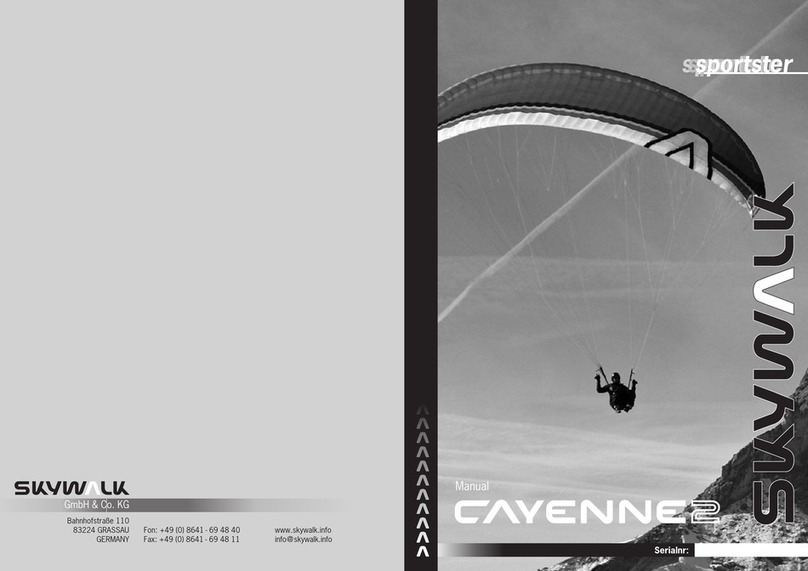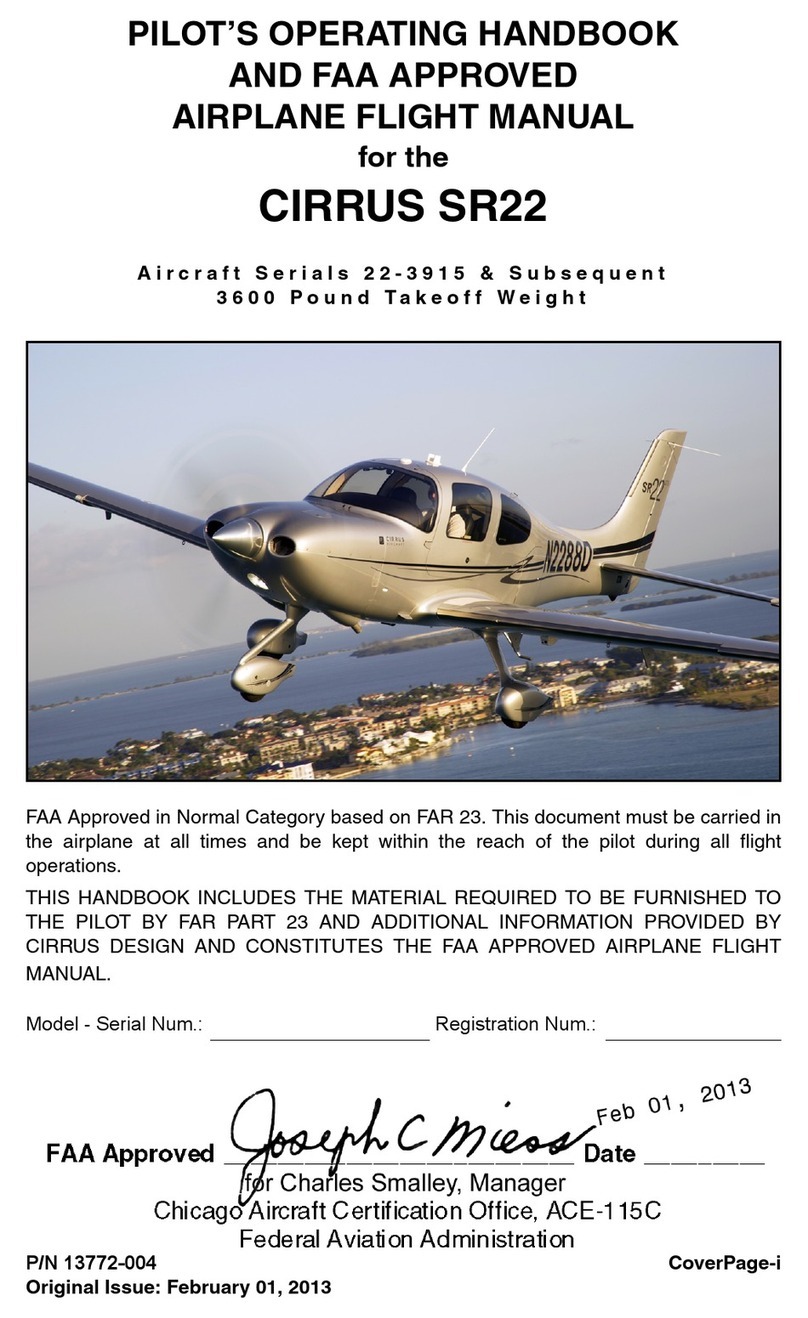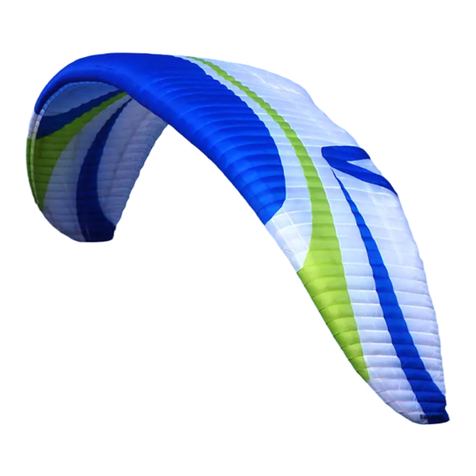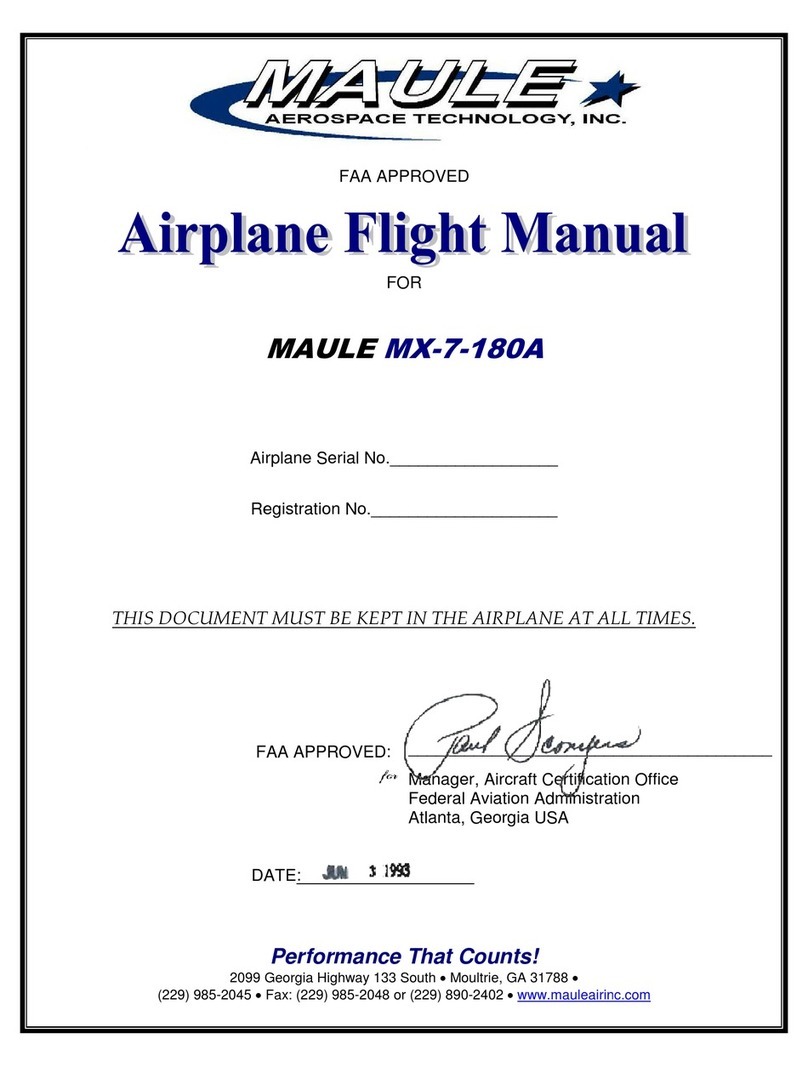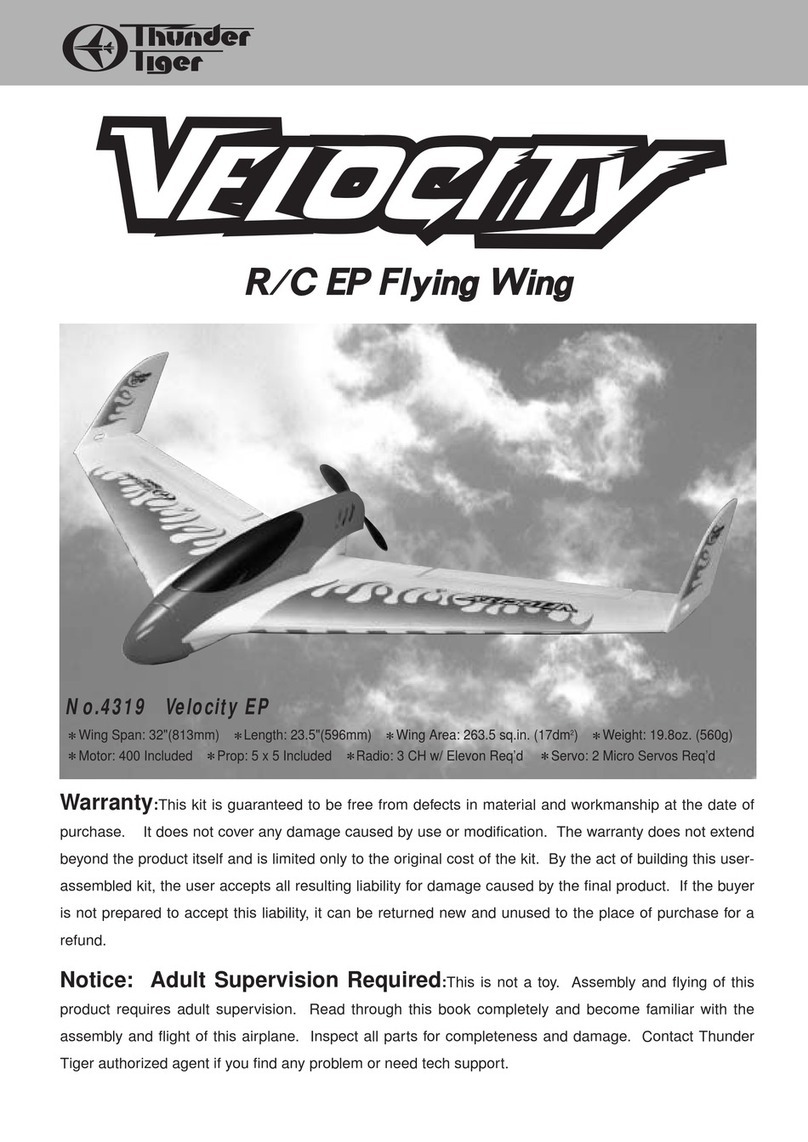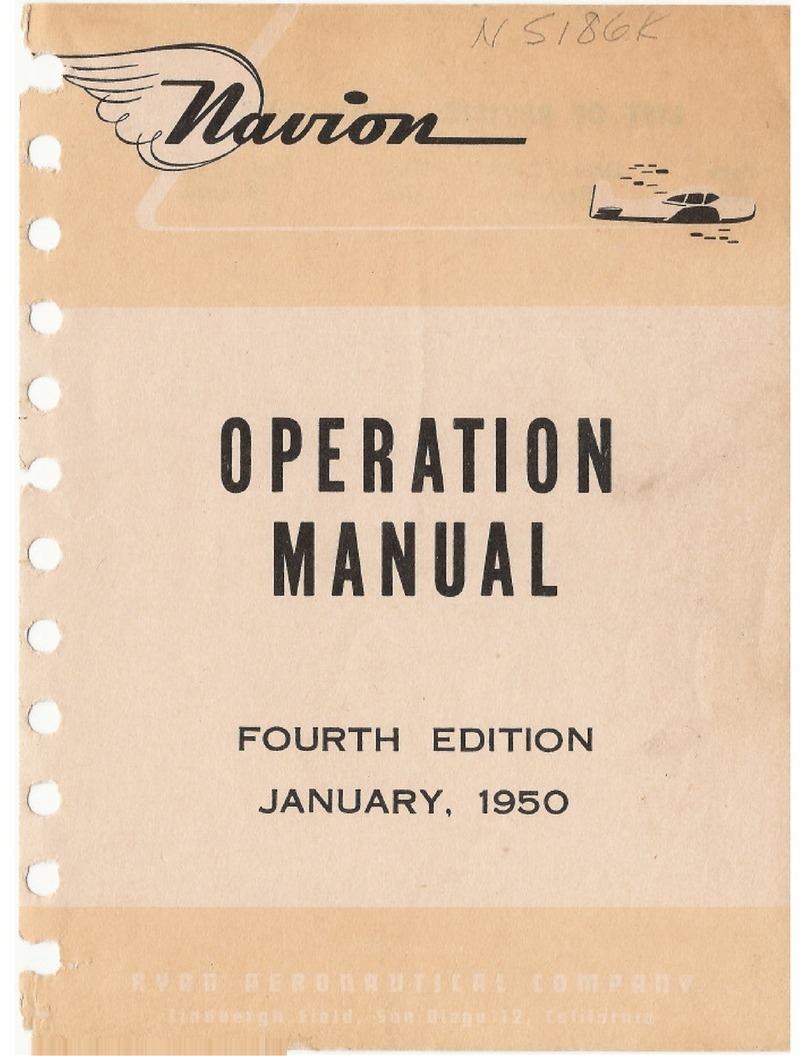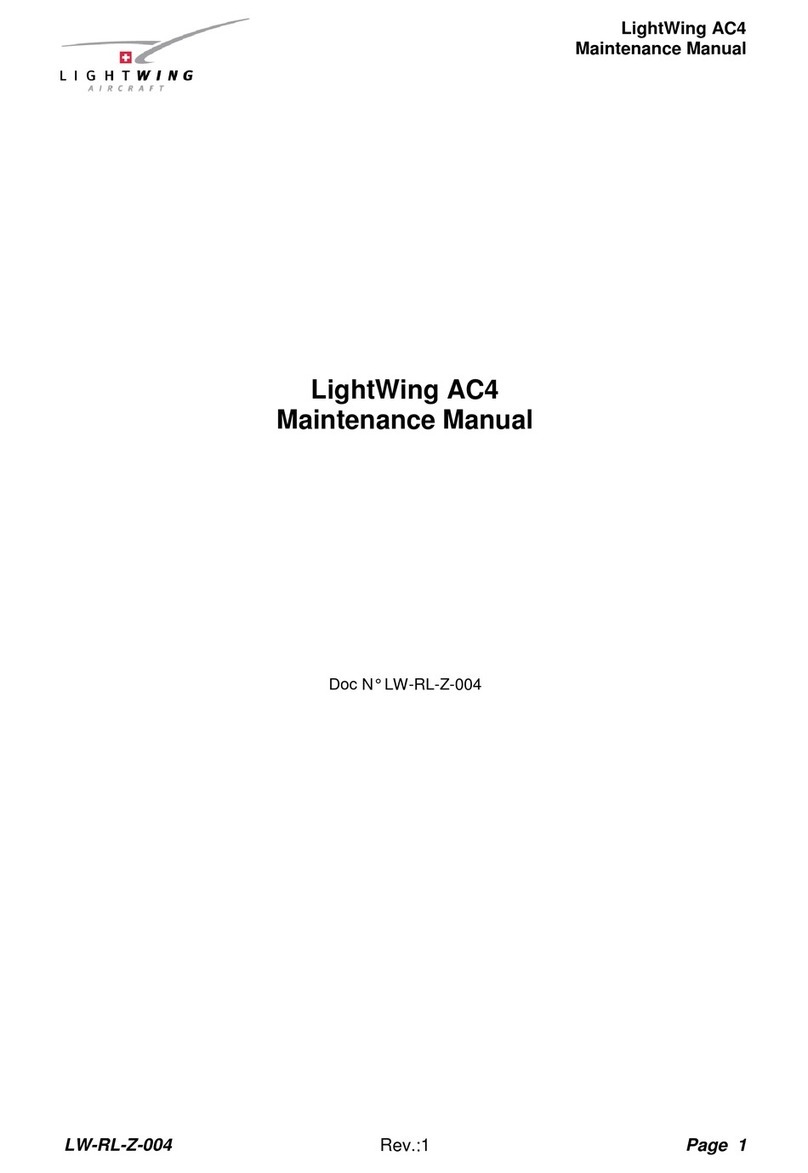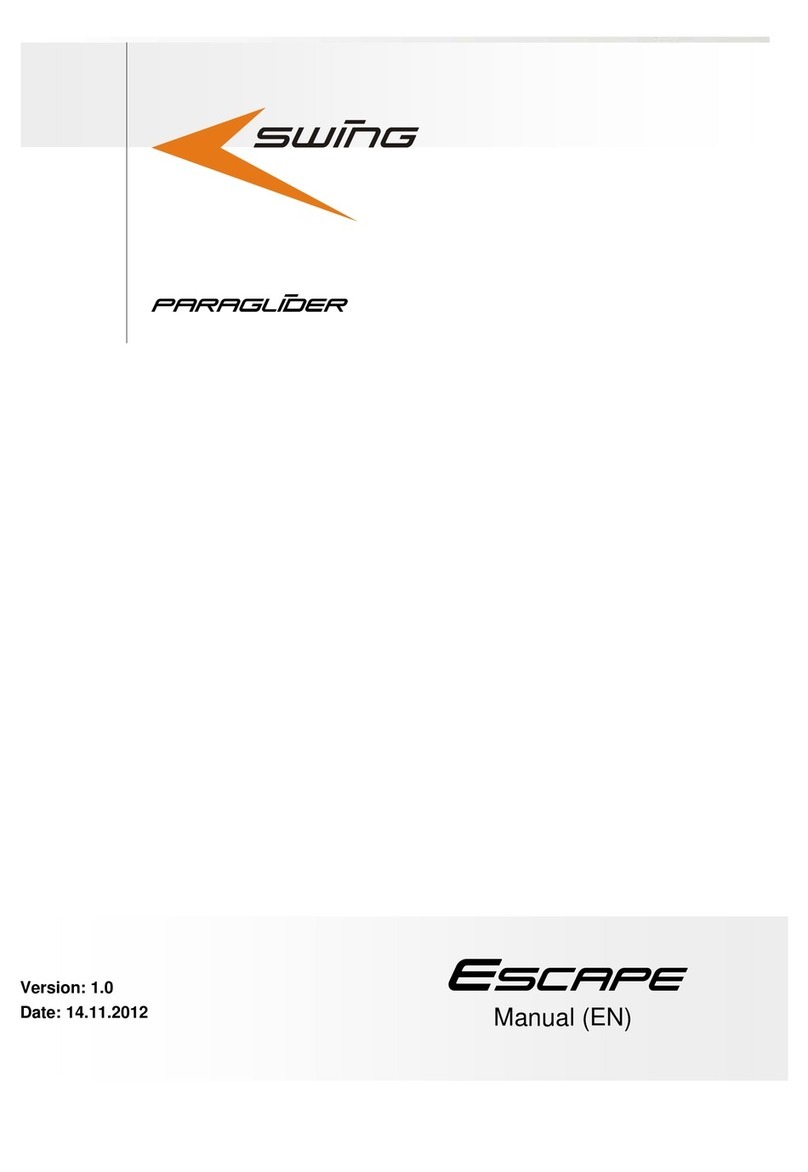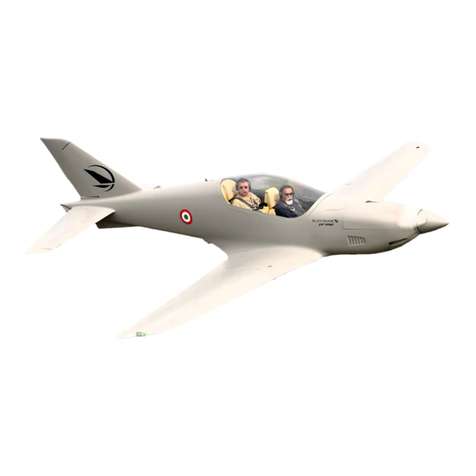DAVINCI GLIDERS OPERA User manual

USER MANUAL
V2.0
01.MAR.2020


Congratulations
Congratulations!
Welcome you in our circle of TEAM DAVINCI.
The OPERA has been designed for top level competitors and expert pilots.
This glider is a unique concept. Despite of impressive AR of 7.8 and lots of cells (128) this
glider is still user-friendly for its category. It has amazing stability, even in accelerated
flight, and it's easy to control, allowing its pilot to concentrate on tactics. There's plenty of
innovations and know-hows packed into this flying machine with impressive look and very
sophisticated design.
This manual will help you to get all information about your glider. We strongly
recommend that you read this manual carefully in order to be aware of any general
limitations, performance characteristics, take off and flight characteristics, landing
procedures, dealing with emergency situations and general maintenance.
Don’t hesitate to contact us or your local dealer, if you have any question.
You can find the latest news from our home page www.flydavinci.com
Happy flying
DAVINCI GLIDERS

➢This is not training manual.
➢You are responsible for understanding the correct and safe use
of this paragliding equipment, for its intended use, and for
performing all appropriate safety procedures before and during
use.
➢Paragliding is a very dangerous activity, and sometimes it can be
lead to severe injury or even death.
➢The manufacturer, designer, distributor, wholesaler and retailer
can not guarantee the safety of users when using this equipment
and are not responsible for damage, injury or death resulting
from the use of this equipment.
➢This paragliding equipment should only be used by pilots under
the direct supervision of qualified competent pilots or competent
qualified paragliding instructors.
➢DAVINCI GLIDERS are carefully manufactured and inspected at
the factory. Please use the glider only as described in this
manual.
➢Do not make any modifications to the glider.
➢As with any sport–without taking the necessary safety
precautions, paragliding can be dangerous.
➢Always wear a helmet and protective clothing when flying a
paraglider.
➢Do not fly in weather of rain, snow, windy, turbulent and cloudy
condition
WARNING
INDEX
⚫Warning
⚫Technical Data
⚫Material Data
⚫Introduction and Target pilot
⚫Harness
⚫Reserve parachute
⚫Risers
⚫Lines
⚫Accelerator system
⚫Pro-flight check
⚫Take-Off
⚫In flight Characteristics
⚫Deflation
⚫SIV with collapse lines
⚫Landing
⚫Packing your OPERA
⚫Maintenance check
⚫Caring tips
⚫Warrantee
⚫Line Plan
⚫Line materials
⚫Overview
⚫CCC certification
⚫Total line length
⚫Canopy measurement

OPERA XS SSM M L XL
CELLS
NUMBER 128
CLOSED 12
FLAT
AREA m219.2 21.0 22.7 23.6 25.5 27.5
SPAN m 12.27 12.83 13.34 13.60 14.14 14.68
ASPECT RATIO
(CCC) 7.84(7.63)
PROJECTED
AREA m216.6 18.1 19.6 20.4 22.0 23.7
SPAN m 10.04 10.50 10.92 11.13 11.57 12.02
ASPECT RATIO 6.08
FLATTENING % 13.66%
CORD
MAX m 1.953 2.043 2.124 2.166 2.251 2.34
AVER m 1.565 1.637 1.702 1.735 1.803 1.873
LINES
HEIGHT m 7.60 7.96 8.27 8.43 8.77 9.10
MAIN 1+1+1/3
RISERS
NUMBER A1+A2+A3/B
TRIMS 140
PILOT WEIGHT
(FREE FLIGHT)
MIN-MAX KG 80-92 85-100 95-110 100-115 110-125 120-135
CERTIFICATION 8G EN926-1/2 KG CCC CCC CCC CCC CCC CCC
GLIDER WEIGHT KG 5.8 6.1 6.6 6.9 7.0 7.3
Materials Data
Technical Data
CANOPY FABRIC CODE SUPPLIER
UPPER SURFACE leading Edge 30D MF DOMINICO TEXTILE CO
UPPER SURFACE except leading Edge SKYTEX 27 Pocher Industires
BOTTOM SURFACE SKYTEX 27 Pocher Industires
PROFILES (supported) 70032 E4D Pocher Industires
PROFILES (unsupported) E91 Pocher Industires
DIAGONALS 70032 E4D Pocher Industires
Plastic Reinforcements 2.5/2.0mm Plastic from korea
TRAILING EDGE REINFORCEMENT Laminated NCV INDUSTRIES
SUSPENSION LINES FABRIC CODE SUPPLIER
UPPER CASCADES 8000U-070/050/025 EDELRID
MIDDLE CASCADES 8000U-130/090/070/050 EDELRID
MAIN 8000U-360/190/050
DSL70
EDELRID
Liros
UPPER STABLE 8000U-050 EDELRID
MAIN STABLE 8000U-050 / DSL 70 EDELRID / Liros
UPPER BRAKE 8000U-025 EDELRID
MIDDLE BRAKE 8000U-070/050 EDELRID
MAIN BREAK 8000U-130 / PPSL160 EDELRID / Liros
RISERS FABRIC CODE SUPPLIER
MATERIAL 12MM polyester GUTH&WOLF GMBH
THREAD 210D/3, 420D/3 COATS THREAD THAILAND
PULLEYS Pulley Ronstan

Introduction/Target Pilot
The OPERA is the result of a dedicated effort of Davinci R&D
team. A totally new and innovative design that has never been
seen before, you can experience high stability, handling, and
effective/maximum lift force in thermal, as well as glide ratio.
The OPERA was born to realize the desire of the pilot to fly
faster, higher and farther.
Based on the 2 liner system, OPERA is the best glider with
minimum air resistance and best glide ratio from
CFD(Computational Fluid Dynamics) and FEM(Finite Element
Method) technology for optimized design.
You can make a new records with your OPERA.
•CCC certification : The OPERA is certified during official
testing as CCC, the glider has been type-tested for “one-
seated” use only.
•Suitability for expert pilots : The OPERA is not suitable for
beginner or intermediate pilots, aerobatics, training or
tandem flights.
•Smart Nose Plus : The Opera has special riser system and
Smart Nose Plus is very unique technology can expect high
glider ratio through dramatically improved safety and
natural control of the glider’s pressure.
Harness
The OPERA is certified for harnesses in Group GH type.
The suspension points of the chosen harness should ideally
have a caraviner distance of approximately 43cm and a height
of 44cm for XS size, 46cm for S, SM, M, L, XL sizes.
We recommend adjusting the harness in a very similar way to
the test adjustment. Excessive cross-bracing increases the risk
of twisting the risers. A looser setting will result in a tendency
to lean towards the collapsed side. Lower hang points reduce
the roll-stability of your harness and can slow down the
reopening of asymmetric collapses. Higher hang points (+2up
to +4 cm) have no influence on inflight safety and can
therefore be tolerated.
Reserve Parachute
We recommend that you need to have two reserves within your
maximum flying weight for each. when you fly with Opera. It should
be installed both side of harness.

LinesRisers
The OPERA has been designed with 2 liner system. The A1
riser is covered with RED webbing to allow for easy
dentification. The A risers are split into three for the efficient
acceleration performance.
A3/STB has been designed this way to make applying big ears
easily. They also feature ergonomic wooden handles for
efficient B-riser control.
OPERA Riser length
Trim Accelerated
A1 552 286
A2 552 320
A3/Stb 552 354
B552 426
Acc(mm) 0 140
Trimmer n/a
•They come in different diameters of Kevlar and lines. They
must to be inspected every 100 hours or 12months maximum.
•In case of Brake lines, it was cut a little longer, so every pilot
can adjust it according to his personal taste. But you must
always leave 10cm before the brakes line starts acting in order
to avoid trailing edge deformation when the wing is fully
accelerated.
•In case the brake handle comes loose during flight or any
brake lines is cut you can use the B riser softly for directional
control instead of brake line.
•You have to check your brake for both to be same always.
Differences to manual lengths should not exceed ±5mm

Pre-flight checkAccelerator System
The OPERA is equipped with a accelerator system.
Normally, CCC glider like the OPERA, it has been certified
within 10cm of travel.
The profile of OPERA has been designed to fly stable through
its entire speed range.
It is useful to accelerate when flying in strong winds or in
extreme descending air. For fitting and positioning the speed
bar consult the instructions of the harness manufacturer.
Before every flight check that the speed bar works freely and
that the lines are long enough to ensure that it is not
engaged permanently.
The use of the accelerator system reduces the angle of attack
and the canopy may be more sensitive to collapses therefore
do not use near the ground or in turbulent air and in case
you are hit by turbulence remove your feet off the speed bar
as quickly as possible. Always far away from the ground when
using the speed bar. We therefore do not advise to use the
speed bar near the ground.
You have to adjust the harness to the speed system so you
can use all the speed travel.
To do so you have to be seated in the ground meanwhile you
are in your harness and adjust the lines by pulling up the
risers with tension. Another person help to do this is
recommended. Make sure also that the speed bar is not
pulling down the risers when you are not using it.
Once all the gear is rigged you have to test the whole speed
travel in calm air.
To know yourself with the glider it is a good idea to perform
practice inflations and ground handling in advance. You
should have no difficulties flying the OPERA for the first time
in suitable conditions, but as with all new equipment.
When you have the new glider, the below points should be
inspected.
•Check the lines are clear and not twisted.
•Connection points between the glider and harness.
•Check that the brake handles are correctly attached and
that each line runs freely through the pulley.
•All harness buckles are closed.
•The Karabiners are fully closed and not damaged.
•The sewing, condition of the lines and connection of the
lines are right
•Internal demage to ribs and diagonal ribs.
•Demage to the top and bottom panels and seams
between panels.

In flight Characteristics
Take-Off
The OPERA has been designed as a foot launchable solo
paraglider only.
To get the right wing shape for the take-off, pull the brake
until the canopy shows at the perfect banana shape on the
flat ground. While inflating the OPERA, you should hold both
of the A2 and A2 risers on your hands. Smoothly and
gradually inflate the wing with stretched.
Do not pull the riser forward or down too far, the front edge
may collapse. Therefore, it is better to follow in the direction
of the lower glider until the glider inflates the angle of flight.
While the glider is inflating, it is important that the center of
gravity of the body stays in front of the feet to constantly
load to the riser.
The OPERA has the best stable glide performance in a
normal position without any brakes. Actually we call it “Trim
speed” condition.
In theory, it shows the best performance at trim speed.
However, when we apply a brake of about 10 cm, it is at a
minimal sink rate, such as a lower sink when we do some
thermaling or apply some brake tension just before the
landing.
If you want to avoid the collapse of your OPERA, you need to
use active flying. For this, you need to control the pitch, keep
the internal pressure of the glider by using the brake or B
streering. But in case of the turbulent condition, you had
better use only the brakes.
Alternative Steering :In the unlikely event, that a brake line
releases from the brake handle, or breaks, or the brake-lines
are tangled up, the glider is maneuverable using the B
riser(rear-risers). By pulling gently on the rear-risers, it is
possible to steer the glider and land safely. Don’t pull the
rear-risers too much, to avoid a deep stall.
⚫Tow launch
The OPERA could be tow-launched. It is the responsibility of pilot to
use the right harness and installed/release staff and to ensure that
they are properly trained in the equipment and systems they use.
All tow pilots must be qualified to tow, use a qualified tow driver
with appropriate certified equipment, and comply with all towing
regulations. When towing, the paraglider must be completely over
the head before starting. In each case, the maximum towing force
should meet to the pilot’s max flight weight.

Asymmetric collapse
Deflations
Although the OPERA has great stability of the flight, strong
turbulence or piloting error may cause a portion of the wing
suddenly to be a deflation. The OPERA is aCCC glider so, it is
essential to do active flying in case of an asymmetric or
frontal collapse. Active flying will reduce the loss of altitude
and a change of direction
Symmetric collapse usually occurs when the pilot has not
predicted a possible response of the glider.
When it has been happened, the OPERA will be recovered by
itself immediately and the OPERA will gain the speed again.
To avoid this situation, it needs the active flying skills.
Pull the both brakes when you may feel the less pressure and
the collapse occurred. And the then release the brake right
after to make the normal condition.
Asymmetric collapse usually happens when the pilot has not
foreseen this possible reaction of the wing.
To prevent the collapse from happening, pull the brake line
corresponding to the compromised side of the wing, this will
increase the angle of attack. If the collapse does happen, the
OPERA will not react violently, the turn tendency is very
gradual and it is easily controlled. Lean your body towards
the side that is still flying in order to counteract the turn and
to maintain a straight course, if necessary slightly slow down
the same side. During keep the course, do not use the over-
braking on your pend side.
The collapse will normally open by itself but if that does not
happen, you need to pull the brake lines at the collapsed
side strongly and release it. You need to repeat this pumping
action several times.
Symmetric collapse
Full stall can occur when you fully pull the both brakes
enough long time. This means that the wing loses its forward
momentum. Also weather conditions can cause a full stall.
This is a serious deviation from normal flight and can be
difficult to manage. If a stall occurs at less than 100 m above
the ground, throw your reserve parachute.
To recover to the normal flight you must release both brakes.
After this usually comes a front dive with a possible front
deflation. An asymmetric recovery (one control released faster
than the other) from a full-stall can cause a big dynamic
collapse. The full-stall is a hazardous maneuver and as such
outside the scope of this manual. You should practice and
learn this maneuver only on a SIV course under professional
instructor.
Full stall

It is possible for gliders to enter a state of deep stall. This can
be caused by several situations including; flying the glider
when wet; very old glider; or after a front/symmetric deflation.
When you meet this situation you should fully raise up the
both brakes and push the A-risers forwards or use the speed
bar symmetrically to regain a normal flight.
The cravat can occur when the tip of the wing comes into the
glider line due to the collapsed situation. When it’s happened,
the first action is to make the glider could not be lost the
course where you go. For this, you need to do weight shift
and pull the brake to the other side of cravat wing until the
glider is stable and go straight.
Once you can control your wing to the course, you need to
pull the brake lines at the cravated side strongly and release
it. You need to repeat this pumping action several times.
If you lost the timing for keeping the course, the glider can
be entered spiral dive.
When you pull the one of the brake too much, a
asymmetrical stall may occur.
If the small cravat can be solved by pulling the stable line.
The full stall maneuver is the last step of the solution to solve
the cravat but you have to know about that skill very well
before try it.
You have to keep in mind that if the rotation is accelerating
and you can not manage the glider, you should open the
reserve parachute system immediately before the low altitude.
Cravat(wing Tangle)
Deep stall
Asymmetrical stall
It can take place when you pull one of the brake too hard, or
while spiraling at a small speed in turbulence you increase
the angle of attack. Rotation in the asymmetrical stall is
called negative spiral. This is one of the most dangerous
flying situations. In order to get out of asymmetrical stall, just
release the brakes. There may follow side thrust forward with
a following wing collapse.
Traditional B-line stalls are not possible with 2 liners glider
like the OPERA.
If you pull the B lines, it will be occurred a full stall.
We strongly do not recommend this maneuver for OPERA.
B stall

SIV with collapse lines
The Opera is certified using the collapse lines. If you want to
try the collapse maneuver during the SIV course, the Opera
needs the collapse lines and attachment points on the glider.
These are optional and need to be added by the pre-order.
For the SIV, we strongly recommend to be carried out by
qualified instructor with safety precautions.
Landing
We recommend to land with trimmers to the normal slow
position. Don’t use the sharp turns or radical maneuvers. The
OPERA is a high speed glider, any action on the brakes may
cause significant reactions. When you are 1-2m over the
ground, you should face into wind and standing upright and
ready to run. Finally you may pull the brakes smoothly for
minimize vertical speed. Don’t hit the ground by your
overtake the glider. If you in windy condition, as soon as you
touch the ground you have to turn around to face the glider
and move towards it during full pulling break symmetrically.
Packing your OPERA
Spread the OPERA completely out on the ground. Separate
the lines to the each side. The OPERA must be folded cell to
cell to keep the plastic reinforcement at the leading edge lie
flat on each other and don’t get bent. Try to pack your
OPERA as loosely as the rucksack allows, because every fold
weakens the fabric. Avoid packing the glider where it is wet
or abrasive conditions(sand, asphalt pavement, concrete).
We recommend when you don’t use the OPERA for a long
time, store OPERA lay on the flat table or bottom without any
bending plastics. Always use the protective bag to avoid
direct contact with the harnesses and buckles of any friction
between the blade and the rucksack.
Maintenance checks
Cleaning should be carried out with only pure water. If the
glider comes in contact with salt water, clean thoroughly with
fresh water. Do not use solvents of any kind, as this may
remove the protective coatings and destroy the fabric.

Caring Tips
•Do not expose your glider to the sun any longer than
necessary
•Keep it away from water and other liquids
•Do not let the front edge hit the ground
•Keep your glider away from fire
•Do not put anything heavy on your glider, do not pack it
in a rucksack too tightly.
•Regularly inspect the canopy, lines, risers and harness. If
you find any defects, contact your dealer or the
manufacturer. Do not attempt to repair the paraglider by
yourselves.
•If you detect a damaged line, inform the dealer or
manufacturer about the line number according to the line
plan
•Keep your OPERA in a bag in a dry well-ventilated place
under neutral temperature and humidity conditions
•If you do not use the glider, then once a month you
should unpack it, ventilate it well, and then pack it back in
the bag
Warrantee
The production guarantees the correctness of the declared
characteristics and the paraglider’s normal performance for
two years or 250 hours flying time after the purchase date.
The producer conducts special, and after warranty repairs and
maintenance at the owners’ request for an extra price. We
recommend to inspect your paraglider (including checking
suspension line strength, line geometry, riser geometry and
permeability of the canopy material) one time at one years,
or every 100 hours of flying time (whichever comes first);
Those inspection must be made by manufacturer, importer,
distributor, dealer or other authorised persons. The checking
must be proven by a stamp on the certification sticker on the
glider as well in the manual book.
The warrantee does not cover
•Damage caused by misuse
•Neglecting the regular maintenance
•Overloading of the glider
•Damage caused by inappropriate landings
•Ignored Caring tips

Line Plan

Lines material
Lines material - Opera XS, S, SM, M
A1 A2 B C BR
1Edlerid 8000U-070 1Edlerid 8000U-070 1
Edelrid 8000U-050
1
Edelrid 8000U-025
1
Edelrid 8000U-025
2 2 2 2 2
3
Edelrid 8000U-050
3
Edelrid 8000U-050
3 3 3
4 4 4 4 4
5 5 5 5 5
6 6 6 6 6
7 7 7 7
8 8 8 8
9 9 9 9
10 10 10 10
11 11 11 11
12 12 12 12
13 13 13
Edelrid 8000U-025
13
14 14 14
15 15 15
16 16 16
17 17
18 18
19 19
20 20
21 21
22 22
23 23
24 24
25 25
H / Middle line
A B BR H/Mid
1
Edelrid
8000U-130 1
Edelrid 8000U-050
1
Edelrid 8000U-025
28000U-090 2 2
3 3 3
4 8000U-130 4 4
58000U-090 5 5
6 6 6
7
8000U-070
7
8 8 BR Mid
9 9 1 Edelrid 8000U-050
10
8000U-050
10 2
11 11
12 12
13
Middle line L / Middle line
A B B BR L/Mid
1
Edelrid
8000U-190
1
Edlerid
8000U-090
1Edelrid 8000U-90 1Edelrid 8000U-070
2 2 2 2
3 3
48000U-130 4 8000U-070
5 5 8000U-090
6
7 8000U-050
Main line
A B BR Main
1
Edelrid
8000U-360 1
Edelrid 8000U-190 1 Edelrid 8000U-070
2 8000U-360 2 2 Liros PPSL160
3 8000U-190 3 8000U-050
ST H 8000U-050
ST L Liros DSL 70

Lines material
Lines material - Opera for L, XL
A1 A2 B C BR
1Edlerid 8000U-070 1Edlerid 8000U-070 1
Edelrid 8000U-050
1
Edelrid 8000U-025
1
Edelrid 8000U-025
2 2 2 2 2
3
Edelrid 8000U-050
3
Edelrid 8000U-050
3 3 3
4 4 4 4 4
5 5 5 5 5
6 6 6 6 6
7 7 7 7
8 8 8 8
9 9 9 9
10 10 10 10
11 11 11 11
12 12 12 12
13 13 13
Edelrid 8000U-025
13
14 14 14
15 15 15
16 16 16
17 17
18 18
19 19
20 20
21 21
22 22
23 23
24 24
25 25
H / Middle line
A B BR H/Mid
1
Edelrid
8000U-130 1
Edelrid 8000U-050
1
Edelrid 8000U-025
28000U-090 2 2
3 3 3
4 8000U-130 4 4
58000U-090 5 5
6 6 6
7
8000U-070
7
8 8 BR Mid
9 9 1 Edelrid 8000U-050
10
8000U-050
10 2
11 11
12 12
13
Middle line L / Middle line
A B B BR L/Mid
1
Edelrid
8000U-230 1
Edlerid
8000U-090
1Edelrid 8000U-90 1Edelrid 8000U-070
2 2 2 2
38000U-190 3
4 4 8000U-070
5 8000U-130 5 8000U-090
6
7 8000U-050
Main line
A B BR Main
1
Edelrid
8000U-470 1
Edelrid 8000U-190 1 Edelrid 8000U-070
2 8000U-360 2 2 Liros PPSL160
3 8000U-230 3 8000U-050
ST H 8000U-050
ST L Liros DSL 70

Overview CCC Certification
The Opera has been certified by the CIVL competition
Class(CCC) 2018 (rev 1.9)
The XS flight test has been tested by the DHV at the
maximum weight in 92kg. The load test had been carried out
max. 135kg for XL size.
For the certification flight tests of all sizes have been carried
out with using the collapse lines.

The measured values at the lower surface of the tailing edge, all depth and spacing of the articulation points were
determined under tensile load of 50N.
The length difference is not more than ±10 mm
AA2 B C
Manual
Sample
Glider Dif Manual Sample
Glider Dif
Manual
Sample
Glider Dif Manual Sample
Glider Dif
17716 7719 -3 7703 7708 -5 7707 7711 -4 7852 7852
0
27646 7651 -5 7624 7626 -2 7621 7628 -7 7712 7714 -
2
37579 7585 -6 7560 7566 -6 7553 7559 -6 7643 7646 -
3
47576 7583 -7 7558 7564 -6 7549 7553 -4 7660 7660
0
57556 7562 -6 7537 7542 -5 7529 7523 67597 7592
5
67535 7546 -11 7517 7521 -4 7510 7503 77628 7623
5
77566 7569 -3 7546 7545 17542 7541 1
87614 7620 -6 7601 7600 17599 7594 5
97546 7549 -3 7531 7534 -3 7538 7532 6
10 7470 7474 -4 7454 7455 -1 7457 7453 4
11 7400 7407 -7 7384 7390 -6 7386 7384 2
12 7391 7400 -9 7380 7384 -4 7378 7373 5
13 7358 7355 37344 7341 37346 7341 5
14 7332 7334 -2 7322 7319 37325 7319 6
15 7351 7356 -5 7337 7337 07343 7342 1
16 7385 7386 -1 7380 7377 37390 7386 4
17 7221 7223 -2 7211 7211 0
18 7155 7159 -4 7147 7148 -1
19 7094 7100 -6 7086 7088 -2
20 7086 7090 -4 7083 7083 0
21 7021 7024 -3 7028 7026 2
22 7020 7016 47024 7018 6
23 6891 6887 46917 6912 5
24 6844 6837 76877 6871 6
25 6818 6810 86849 6846 3
Total line length
XS (Scale factor : 1) S (Scale factor : 1.0444)
AA2 B C
Manual
Sample
Glider Dif Manual Sample
Glider Dif Manual Sample
Glider Dif Manual Sample
Glider Dif
18067 8067 08052 8053 -1 8046 8046 08196 8192 4
27994 7992 27971 7964 77957 7960 -3 8051 8050 1
37925 7931 -6 7905 7903 27888 7891 -3 7981 7982 -1
47923 7925 -2 7904 7905 -1 7883 7883 07999 8004 -5
57902 7904 -2 7882 7880 27863 7860 37934 7934 0
67881 7882 -1 7861 7860 17844 7844 07966 7968 -2
77914 7911 37893 7892 17877 7876 1
87965 7966 -1 7951 7946 57936 7933 3
97894 7900 -6 7879 7882 -3 7874 7876 -2
10 7816 7821 -5 7798 7799 -1 7790 7791 -1
11 7742 7746 -4 7725 7728 -3 7716 7713 3
12 7733 7733 07721 7719 27708 7705 3
13 7700 7701 -1 7684 7679 57676 7677 -1
14 7672 7671 17662 7658 47654 7653 1
15 7692 7689 37677 7671 67672 7672 0
16 7728 7725 37722 7713 97721 7717 4
17 7565 7562 37533 7537 -4
18 7496 7493 37465 7468 -3
19 7432 7432 07402 7404 -2
20 7424 7423 17399 7396 3
21 7355 7353 27336 7335 1
22 7349 7344 57337 7340 -3
23 7204 7208 -4 7236 7236 0
24 7155 7158 -3 7194 7195 -1
25 7128 7131 -3 7166 7164 2

The measured values at the lower surface of the tailing edge, all depth and spacing of the articulation points were
determined under tensile load of 50N.
The length difference is not more than ±10 mm
Total line length
SM (Scale factor : 1.0888) M (Scale factor : 1.1111)
AA2 B C
Manual
Sample
Glider Dif Manual Sample
Glider Dif Manual Sample
Glider Dif Manual Sample
Glider Dif
18543 8535 88522 8522 08532 8532 08689 8686 3
28466 8462 48436 8431 58438 8436 28536 8535 1
38394 8391 38368 8369 -1 8365 8364 18462 8458 4
48393 8390 38367 8373 -6 8361 8358 38482 8482 0
58371 8372 -1 8345 8353 -8 8341 8342 -1 8415 8412 3
68350 8349 18324 8329 -5 8321 8322 -1 8450 8448 2
78386 8384 28357 8362 -5 8358 8357 1
88439 8435 48419 8422 -3 8421 8418 3
98365 8364 18343 8349 -6 8355 8360 -5
10 8282 8282 08258 8268 -10 8267 8269 -2
11 8205 8206 -1 8182 8191 -9 8188 8189 -1
12 8195 8196 -1 8178 8184 -6 8180 8181 -1
13 8161 8155 68139 8137 28145 8145 0
14 8132 8127 58116 8111 58122 8123 -1
15 8153 8145 88132 8129 38142 8136 6
16 8191 8176 15 8179 8169 10 8193 8190 3
17 8014 8014 08006 8000 6
18 7942 7943 -1 7934 7934 0
19 7874 7875 -1 7868 7867 1
20 7865 7868 -3 7864 7863 1
21 7791 7793 -2 7793 7797 -4
22 7784 7781 37788 7778 10
23 7641 7640 17676 7678 -2
24 7590 7591 -1 7631 7633 -2
25 7561 7563 -2 7601 7605 -4
AA2 B C
Manual
Sample
Glider Dif Manual Sample
Glider Dif
Manual
Sample
Glider Dif Manual Sample
Glider Dif
1
2
3
4
5
6
7
8
9
10
11
12
13
14
15
16
17
18
19
20
21
22
23
24
25

The measured values at the lower surface of the tailing edge, all depth and spacing of the articulation points were
determined under tensile load of 50N.
The length difference is not more than ±10 mm
Total line length
L (Scale factor : 1.1555) XL (Scale factor : 1.2000)
AA2 B C
Manual
Sample
Glider Dif Manual Sample
Glider Dif
Manual
Sample
Glider Dif Manual Sample
Glider Dif
18889 8892 -3 8867 8870 -3 8867 8866 19023 9020 3
28810 8812 -2 8779 8784 -5 8770 8769 18865 8867 -2
38735 8744 -9 8708 8719 -11 8697 8695 28790 8793 -3
48734 8740 -6 8707 8714 -7 8693 8693 08811 8812 -1
58712 8716 -4 8685 8690 -5 8671 8672 -1 8742 8740 2
68690 8694 -4 8663 8669 -6 8651 8649 28778 8774 4
78727 8729 -2 8698 8697 18689 8688 1
88783 8779 48762 8761 18754 8748 6
98708 8715 -7 8685 8691 -6 8686 8688 -2
10 8622 8628 -6 8597 8603 -6 8594 8598 -4
11 8541 8547 -6 8517 8522 -5 8515 8519 -4
12 8532 8533 -1 8513 8519 -6 8506 8512 -6
13 8496 8497 -1 8473 8472 18470 8469 1
14 8466 8467 -1 8449 8449 08446 8449 -3
15 8488 8489 -1 8466 8468 -2 8467 8467 0
16 8527 8522 58515 8511 48520 8520 0
17 8344 8350 -6 8325 8325 0
18 8268 8275 -7 8251 8250 1
19 8197 8205 -8 8182 8177 5
20 8188 8193 -5 8178 8175 3
21 8111 8114 -3 8113 8104 9
22 8103 8105 -2 8098 8096 2
23 7951 7952 -1 7987 7983 4
24 7897 7898 -1 7940 7936 4
25 7868 7866 27909 7909 0
AA2 B C
Manual
Sample
Glider Dif Manual Sample
Glider Dif
Manual
Sample
Glider Dif Manual Sample
Glider Dif
19218 9209 99195 9185 10 9205 9192 13 9371 9358 13
29136 9126 10 9104 9094 10 9105 9097 89208 9203 5
39060 9054 69031 9027 49029 9011 18 9130 9114 16
49059 9054 59031 9022 99026 9007 19 9153 9134 19
59037 9036 19008 9007 19004 8990 14 9082 9070 12
69014 9012 28986 8984 28983 8968 15 9120 9110 10
79053 9046 79022 9021 19023 9007 16
89111 9102 99089 9079 10 9091 9075 16
99034 9026 89011 9006 59027 9016 11
10 8946 8937 98920 8915 58932 8923 9
11 8862 8858 48837 8834 38848 8841 7
12 8852 8844 88833 8828 58840 8829 11
13 8815 8809 68791 8788 38803 8792 11
14 8784 8774 10 8766 8760 68779 8770 9
15 8806 8796 10 8783 8773 10 8799 8790 9
16 8847 8833 14 8834 8823 11 8855 8843 12
17 8657 8653 48656 8651 5
18 8579 8579 08579 8574 5
19 8504 8502 28507 8501 6
20 8495 8494 18503 8500 3
21 8417 8418 -1 8436 8432 4
22 8408 8408 08430 8417 13
23 8264 8253 11 8302 8293 9
24 8208 8198 10 8253 8244 9
25 8178 8169 98221 8208 13
Table of contents
Other DAVINCI GLIDERS Aircraft manuals
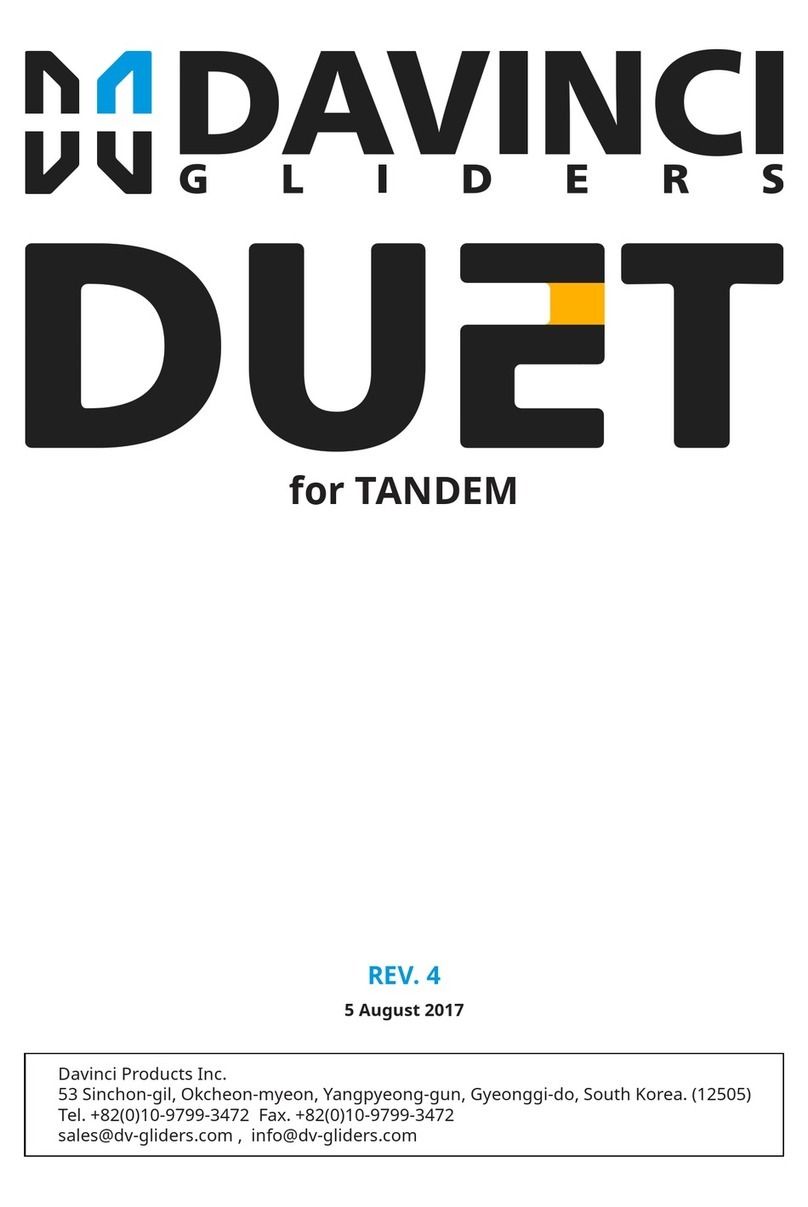
DAVINCI GLIDERS
DAVINCI GLIDERS DUET User manual

DAVINCI GLIDERS
DAVINCI GLIDERS DUET User manual
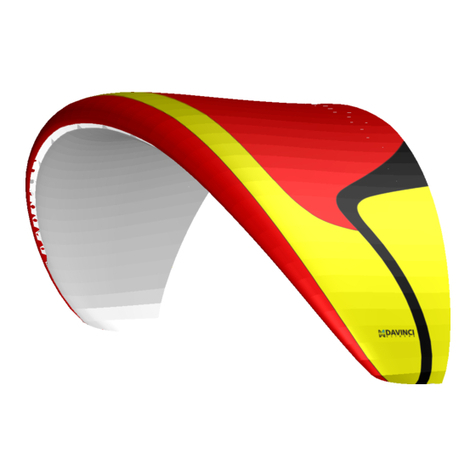
DAVINCI GLIDERS
DAVINCI GLIDERS JAZZ 21 User manual

DAVINCI GLIDERS
DAVINCI GLIDERS Point User manual
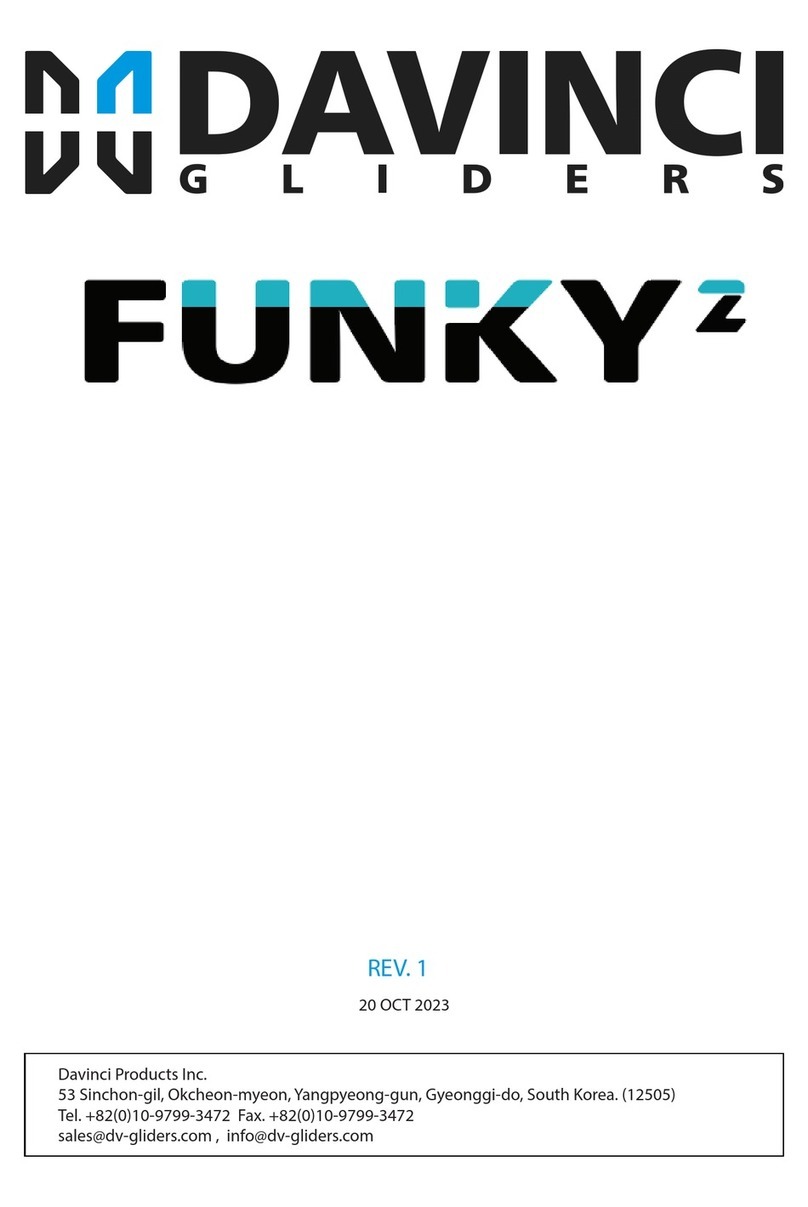
DAVINCI GLIDERS
DAVINCI GLIDERS Funky2 User manual
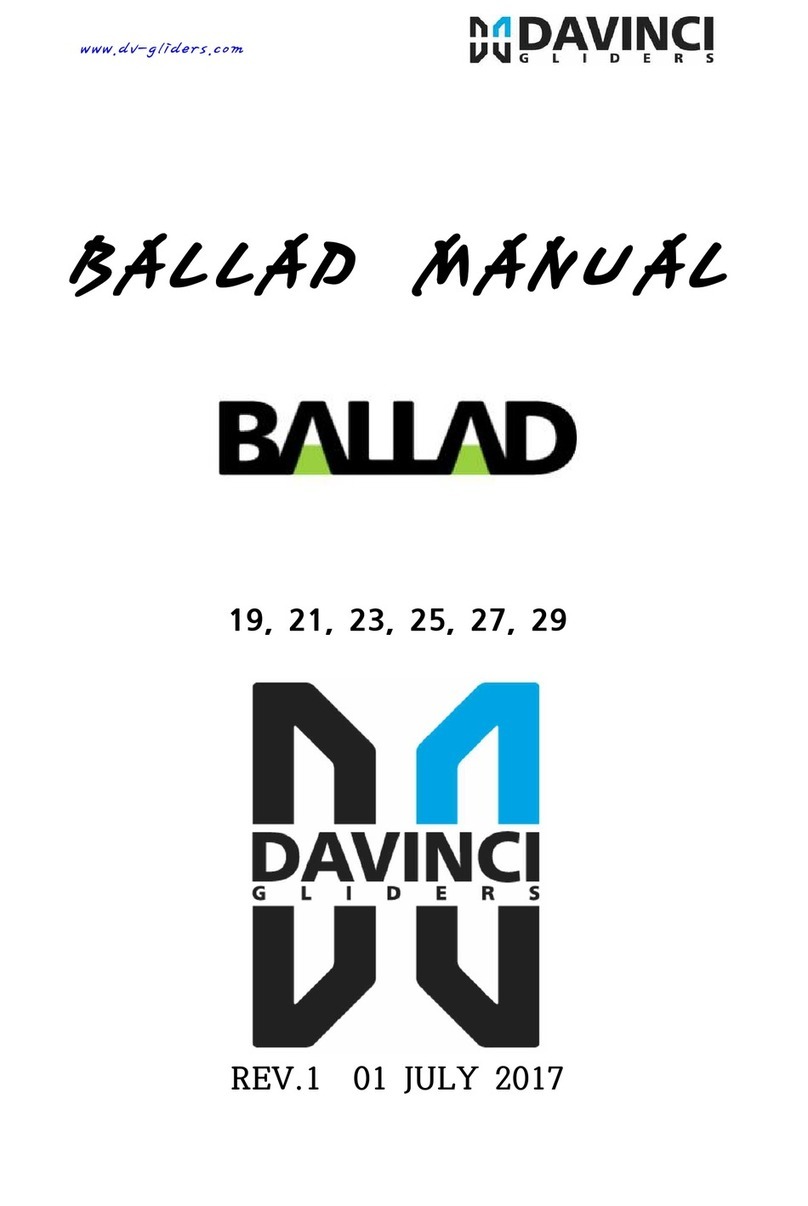
DAVINCI GLIDERS
DAVINCI GLIDERS BALLAD 19 User manual
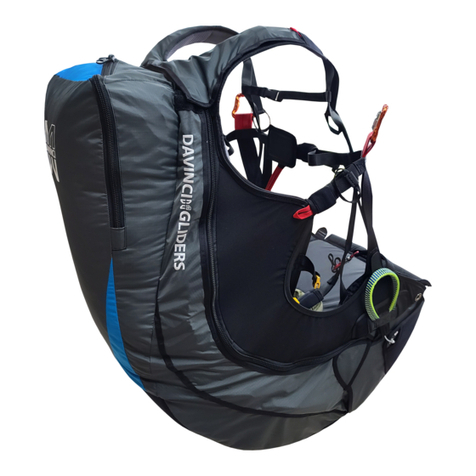
DAVINCI GLIDERS
DAVINCI GLIDERS SOUL User manual
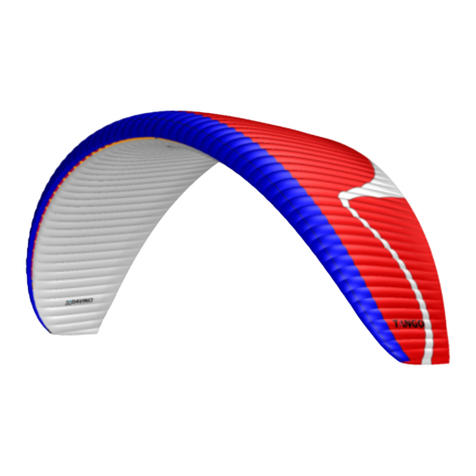
DAVINCI GLIDERS
DAVINCI GLIDERS TANGO XS User manual
